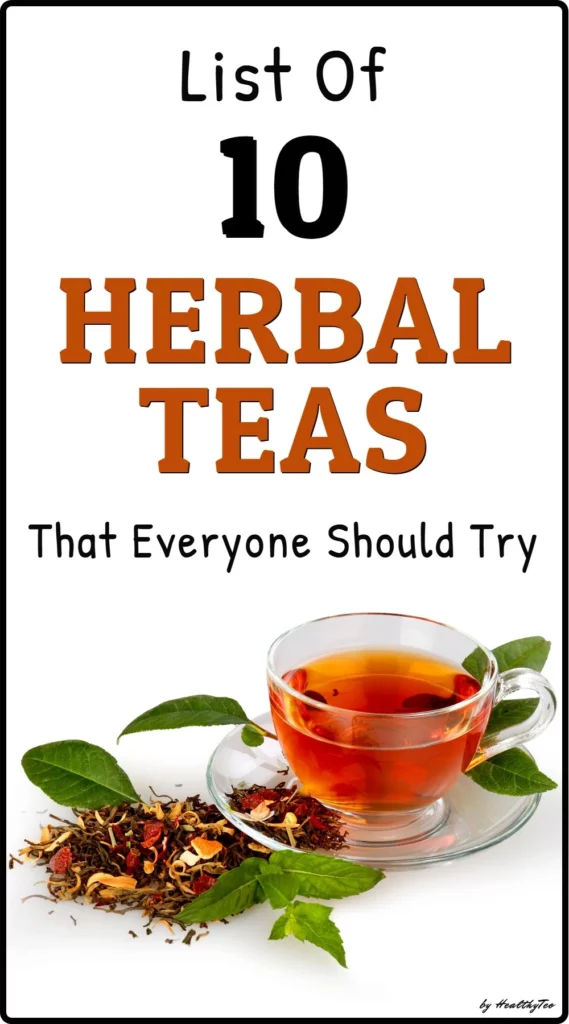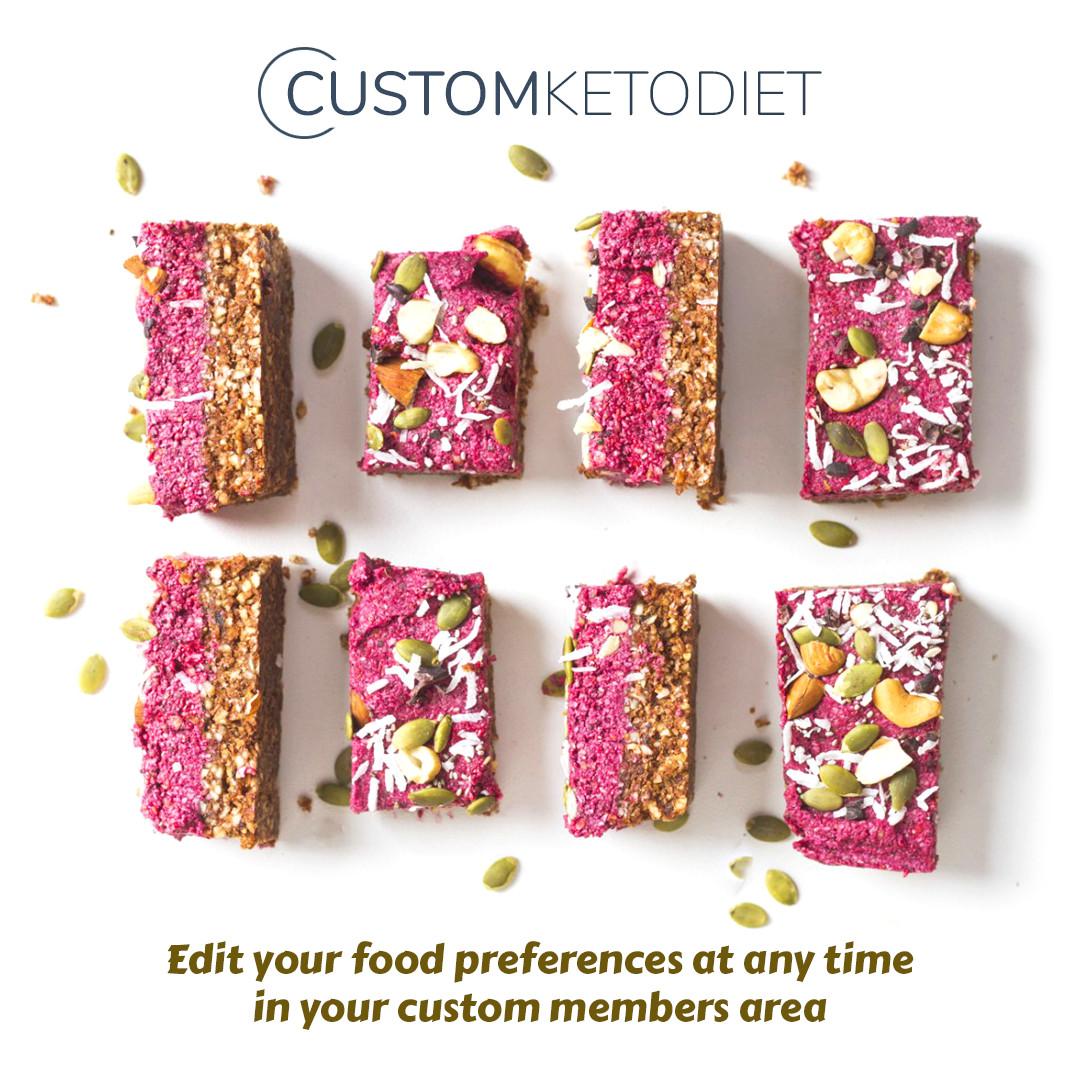Herbal teas are a great alternative to sugary beverages; most are caffeine-free and come in a variety of flavors.
This article will provide you with a list of the most popular herbal teas. But first, let’s go over the fundamentals of herbal teas!
Herbal tea is an infusion or blends of various leaves, roots, bark, fruits, or flowers from almost any edible non-tea plant. Tisanes are the common name for herbal teas in Europe and other parts of the world.
Herbal teas have nothing in common with true teas. True teas, such as green tea, black tea, white tea, and oolong, are all derived from the Camellia sinensis plant.
Herbal teas can be found in a variety of tastes and flavors, and they are a great alternative to sugary beverages and water.
We can’t show them all because there are so many different types of herbal tea. As a result, we’ve decided to introduce you to the ten most popular types of herbal teas and their characteristics.
This post may contain affiliate links, which means we may receive a small commission, at no cost to you, if you make a purchase through a link. For more information, please see our disclosure.
Popular types of herbal tea that you should try
- Chamomile Tea
- Ginger Tea
- Peppermint Tea
- Hibiscus Tea
- Rooibos Tea
- Sage Tea
- Bay Leaf Tea
- Lemon Balm tea
- Rose Hip Tea
- Tulsi Tea
The characteristics of each of these herbal teas are listed below.
Chamomile Tea
This is probably the most popular herbal tea. Chamomile tea is a herbal tea or tisane made from the dried flowers of the chamomile plant and infused in hot water.
Chamomile refers to two plants: German chamomile and Roman chamomile.
According to research, German chamomile flowers have the highest concentrations of beneficial compounds and nutrients that can be imparted to those who drink this popular tea on a regular basis.
Chamomile tea is well-known for its calming properties and is frequently used as a sleep aid. A cup of chamomile tea before bed can help you relax and fall asleep faster, resulting in a restful, long, and uninterrupted night’s sleep.
Read more: The Best Herbal Teas That May Help You Sleep Better
Chamomile has a flavor profile that includes herbal and fruity notes, as well as a refreshingly smooth finish. Chamomile gets its name from the Greek words “chamai melon,” which means “ground apple.” Its flavor is often compared to that of a crisp apple.
If you are allergic to flowers in the daisy family, you should avoid drinking chamomile tea. If you are allergic to chamomile, chrysanthemums, daisies, marigolds, or ragweed, avoid drinking chamomile tea.
Because research on the long-term effects of chamomile and pregnancy is still in its early stages, it is usually advised to avoid chamomile while pregnant.
Brewing chamomile tea – You should use hot water. Heat your water to 200 degrees Fahrenheit before steeping loose flowers or a chamomile tea bag.
Steep time should be at least 5 minutes. Even after infusing for more than 5 minutes, chamomile will not become bitter.
Ginger Tea
Ginger tea is made from ginger root, which is native to Asia but is now grown all over the world.
Ginger tea is excellent for nausea and stomach upset. Ginger has been shown in studies to be effective at relieving nausea, particularly in early pregnancy, though it may also relieve nausea caused by motion sickness.
When you choose ginger tea, it is not really sweet or savory, but rather herbal. It has a grassy, non-bitter flavor. Typically, it’s combined with citrus and other fruits that complement ginger’s naturally earthy flavor.
If you want to learn how to make this delicious tea quickly, Alpha Foodie has a great article on how to make ginger tea with fresh ginger and leftover ginger juice pulp.
Peppermint Tea
Peppermint is an aromatic herb from the mint family that is native to Europe and Asia.
Menthol, menthone, and limonene are among the essential oils found in peppermint leaves. Peppermint gets its cooling properties and distinctive minty scent from menthol.
One of the most beneficial properties of peppermint is that it helps to keep your breath fresh.
While peppermint tea is commonly consumed for its flavor, it also has numerous health benefits.
This herbal tea is commonly used to aid digestion, relieve bloating, and reduce the frequency and severity of abdominal pain.
Peppermint tea, like most teas, can have a few minor side effects. People who suffer from acid reflux or who are allergic to its ingredients, such as menthe, should avoid this tea.
More information on the benefits and side effects of peppermint tea is here.
Hibiscus Tea
Hibiscus tea is made by boiling parts of the hibiscus plant. It is also known as roselle or red tea.
This tea has a sour flavor and a ruby red or deep magenta color.
Hibiscus tea can be consumed alone or as a component of other tea blends. It is suitable for both hot and cold servings.
A refreshing summer treat is an iced hibiscus mixed with lemonade!
Hibiscus tea has been shown in studies to help lower blood pressure. According to research, drinking hibiscus tea on a daily basis can help treat high blood pressure in adults with mild hypertension, making it a healthy addition to the diet for people with high blood pressure.
However, consuming hibiscus tea IS NOT recommended for those who already have low blood pressure or hypotension. Additionally, hibiscus tea is not recommended for pregnant women or those taking diuretics.
Before using hibiscus tea, always check with your doctor if you are taking any medications.
Find out more about this herbal tea in this detailed article about the benefits, side effects of hibiscus tea, and how to prepare it at home.
Rooibos Tea
Rooibos tea is a red herbal tea made from the long needle leaves of the Aspalathus linearis plant.
The leaves are green when still growing on the plant, but they turn red during the fermentation process.
Rooibos is primarily grown in the mountains of South Africa.
This tea is available in two varieties: red rooibos and green rooibos. Red rooibos tea is oxidized and tastes more like black and oolong tea. Green rooibos tea is unoxidized and has a flavor similar to green tea.
Rooibos tea is high in antioxidants, with the green variety having a higher concentration than the red. The antioxidants quercetin and aspalathin are two of the most notable in tea. Antioxidants are important for human health because they prevent free radicals from causing cell damage.
Find out more about the health benefits of rooibos tea here.
Rooibos tea has a sweet, nutty flavor similar to hibiscus tea, as well as earthy notes similar to yerba mate infusions. It brews into a beautiful reddish-brown color that is as tasty as it is visually appealing. It can be served hot or cold.
Sage Tea
Sage tea is a beverage made by steeping hot water with the leaves of common sage (Salvia officinalis), a herb related to mint.
Camphor and carnosol found in sage can help prevent skin damage. It may also speed up wound healing and kill pathogenic bacteria and fungi.
Sage is a popular herb in dentistry because it treats pain, inflammation, and bad breath. In fact, gargling sage tea is frequently recommended as a treatment for mouth wounds and sore throats.
However, you might just want to drink it for the taste. It’s light and sweet, with earthy notes. The aromatic scent will make you feel warm and cozy. Many people prefer to drink sage tea between meals because it allows them to fully appreciate its distinct flavor.
Potential side effects: Sage tea contains thujone, a compound that gives it its distinctive aroma but can be toxic in high doses.
Sage tea contains only 4-11 mg of this compound per 4 cups (1 liter), so you can drink several cups per day without worrying about thujone toxicity.
You should not consume large amounts of this tea for extended periods of time; however, a few mugs per day are likely safe.
Bay Leaf Tea
Bay leaf tea, as the name suggests, is a herbal tea made with hot water and bay leaves.
Bay leaves, which are native to the Mediterranean region as well as North and Central America, are derived from bay laurel trees and have long been used in soups, stews, and sauces due to their strong, slightly bitter flavor. And, like most herbs, bay leaves have long been used to brew and enjoy as tea.
Because it stimulates and supports the digestive system, a bay leaf tea is ideal for drinking before meals. Consuming a cup of this herbal tea 30 minutes before eating allows it to get to work in the body before food consumption. It has also been linked to helping with gas and bloating.
More on how to make it and the potential benefits and side effects of bay leaf tea here.
A word of caution: It is critical that you use a true bay leaf derived from the laurel tree when making this tea. Other varieties can be toxic when consumed, so make sure you’re getting the real thing. If you are allergic to other Lauraceae family members, you should avoid bay leaf tea as well.
Lemon Balm Tea
The leaves of the lemon balm plant, Melissa officinalis, are used to make lemon balm tea. Melissa tea is another name for lemon balm tea.
When your stomach is upset or you need to relax your body and mind, drink lemon balm tea.
This herbal tea has a lightly sweet flavor with a hint of lemon. The tart and sweet combination creates a distinct flavor, while a herbal aroma completes the flavor profile.
The mild, lemony mint flavor complements honey and a slice of lemon.
Rose Hip Tea
The fruit of the rose plant is used to make this herbal tea. Rose hips are the rounded parts of the flower that sit just below the petals. They’re also known as dog rose fruit and hip fruit.
Rose hip tea is high in antioxidants and vitamin C. The tangy, sweet flavor is also due to the high vitamin C content. More information about the health benefits of rose hip tea can be found here.
Rose hip tea’s flavor and appearance are frequently compared to hibiscus tea. It has a delicate floral flavor that is followed by a tart aftertaste. Rose hip tea has a deep red color and a tangy and sweet aroma when brewed.
You can add agave or honey to this tea to bring out the naturally sweet flavors.
Tulsi Tea
Holy basil is an aromatic plant that belongs to the same family as sweet basil. Tulsi, tulasi, and Queen of the Herbs are all names for holy basil.
Look for deeply veined green leaves and pale purple flowers to identify holy basil.
Tulsi tea may be beneficial in reducing anxiety. Tulsi is an adaptogenic herb, which means it can help protect the body from the toxins caused by stress.
According to a 2017 review of studies, tulsi has been associated in multiple studies with an improvement in mood and reduced anxiety levels. Scientists believe that the flavonoids in tulsi tea may help reduce the body’s cortisol levels, which are commonly referred to as the “stress hormone.”
Tulsi has a fascinating flavor that is both pleasing and unique. It has a semi-sweet and minty spiciness to it. It can be floral and peppery at the same time, though some varieties have a clove aroma with that spiced flavor. Others will have a more lemony flavor.
The flavor of tulsi tea may differ slightly from one brand to the next. Because there are several varieties of tulsi, this is completely natural. So have fun and experiment with different brands until you find one that you truly adore.
Is there caffeine in herbal tea?
The majority of herbal teas are caffeine-free. Yerba mate and guarana tea are the two exceptions.
Caffeine is also purposefully blended into some herbal teas. Check the label for added tea blends as well as added ingredients such as cacao or kola nut.
Yerba Mate Tea
Yerba mate is a herbal tea made from the Ilex paraguariensis plant’s leaves and twigs. This is a traditional South American drink that is gaining popularity around the world.
Yerba mate is traditionally consumed from a gourd (special cup) and sipped through a metal straw (bombilla) with a filter at the lower end to strain out the leaf fragments. Order a complete yerba mate set here.
Surprisingly, mate contains more caffeine than coffee. But it’s “cleaner,” because it doesn’t give you a buzz or crash like coffee does. However, the more leaves you add, the stronger the resulting drink will be.
Read more: Yerba Mate Tea: Benefits, Potential Risks and How To Brew It Properly
Guarana Tea
Guaran herbal tea is made from the seeds of the Amazonian plant Paullinia cupana. This is a lesser-known South American herbal tea with high caffeine content.
1 gram of guarana seed contains 47mg of caffeine, which is roughly equivalent to a cup of black tea.
Artificially added caffeine in herbal teas
This is common with herbal teas. For example, “forest fruit tea” is actually black tea flavored with forest fruits, which is mentioned in small print on the back.
Check to see if your herbal tea contains any of the following teas: black, green, white, oolong, or Pu-erh. They are all caffeine-containing teas, and even a small amount of these teas in your herbal tea will increase the caffeine content of your cup.
Another type of caffeinated herbal tea is less obvious.
The actual ingredients are only the plants used to make herbal tea, but caffeine is artificially added while the tea is being processed. There will be no other tea or coffee added to it.
It’s just caffeine, and there should be a label that says “caffeinated” or “added caffeine.” Check the ingredients on the back, especially if you’re buying teabags.

Final thoughts on the most popular types of herbal tea
As you can see from the examples above, there are numerous herbal teas available. They all have a distinct flavor and are extremely tasty.
Except for yerba mate and guarana tea, which contain caffeine, they can be consumed at any time of day. Always check the label to ensure that your herbal tea is caffeine-free, as caffeine may be added artificially.
When brewing herbal tea, use hot water; the steeping time is longer than for true teas, around 5-10 minutes.
If you’re using herbal tea bags, read the directions to find out what the best steeping time is for your particular tea. Loose herbs may also come with brewing instructions, but if not, the general rule is that the harder the ingredients, the longer the steep time required.
If you’re new to herbal teas, don’t be afraid to try some of these ten herbal teas. If you are taking any medications, check with your doctor before trying a new herbal tea.
Finally, brew a perfect cup of herbal tea of your choice and enjoy!




